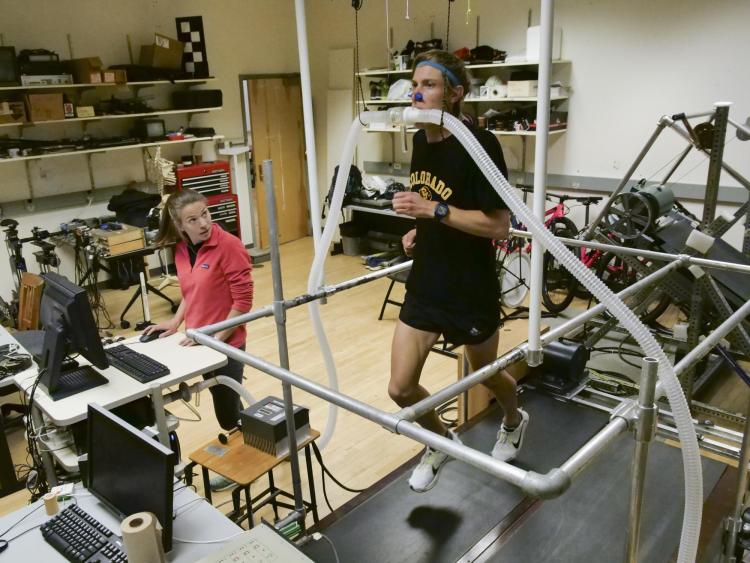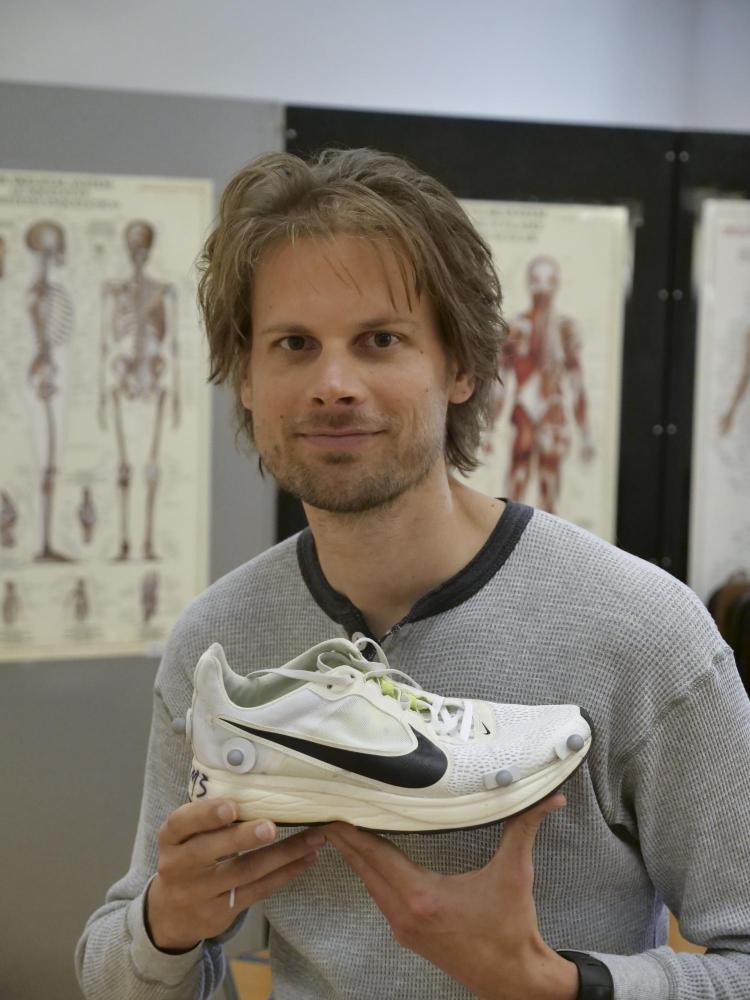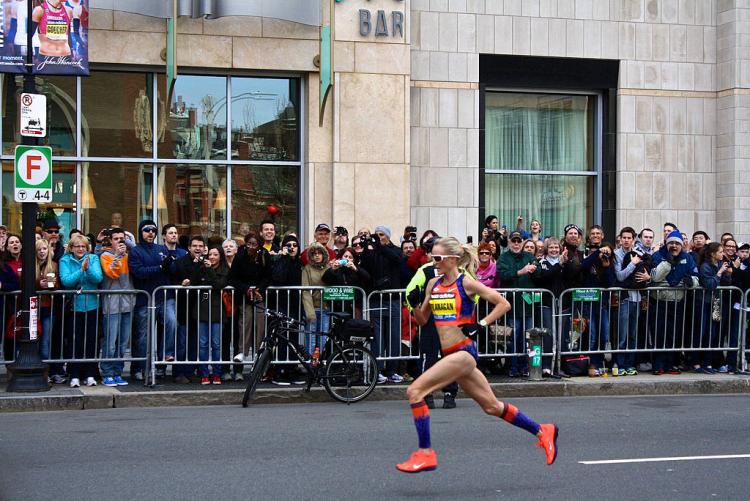New shoe makes running 4 percent easier, 2-hour marathon possible, study shows
Eleven days after Boulder-born Shalane Flanagan won the New York City Marathon in new state-of-the-art racing flats known as “4%s,” University of Colorado Boulder researchers have published the study that inspired the shoes' name, confirming in the journal Sports Medicine that they reduce the amount of energy used to run by 4 percent.
With such technology—including next-generation foam cushioning, carbon fiber plates and a thick but soft midsole—runners at a variety of speeds should be able to significantly improve their times; and for elites, the elusive two-hour marathon is now within reach, the authors conclude.
“Our extrapolations suggest that with these shoes the technology is in place to break the two-hour marathon barrier,” said lead author Wouter Hoogkamer, a postdoctoral researcher in the Locomotion Lab at CU Boulder. “Now, it is up to the athletes to make it happen.”

Boulder-based runner Andy Wacker tests a new state-of-the art prototype shoe in the CU Boulder Locomotion Lab as graduate student Shalaya Kipp looks on. (Photo by University of Colorado/Casey Cass)
The study was conducted at the CU lab before the shoe’s July release and prompted Nike to name it the Zoom Vaporfly 4%. Today’s long-awaited publication reveals in detail what the researchers found and how it was done.
For the study, Hoogkamer and his team recruited 18 male runners in their 20s who had run a 10 km race in less than 31 minutes (a pace of about 5 minutes per mile) and also wore a size 10 shoe.

Postdoctoral researcher Wouter Hoogkamer with a prototype of the 4%.
“We were looking for fast, male Cinderellas,” said senior author Rodger Kram, a professor in the Department of Integrative Physiology. “There are very few places in the world outside of Boulder that we could have found so many fast runners.”
Each runner came to the lab on three separate testing days. Each day, they ran six 5-minute treadmill trials wearing each of three pairs of shoes twice: the prototype of the Nike Zoom Vaporfly 4%, the Nike Zoom Streak and the Adidas Adios Boost 2, which Kenyan Dennis Kimetto wore when he set the official marathon world record (2:02:57) in 2014.
The 10 fastest marathons have been run in versions of the latter two shoes.
“We wanted to test this new prototype shoe against the best out there,” said co-author Shalaya Kipp, an Olympic middle-distance runner and graduate student in the lab.
On one day, participants ran at a pace of 5:22 minutes per mile; on another they ran at a 6:02 pace; on another they ran at a 6:54 pace.
Meanwhile, they breathed into a device that measures oxygen consumption to ascertain calories burned per second during running. When wearing the prototype shoe, their energy savings was between 2 percent and 6 percent, with an average of 4 percent.
“Every single day at every single speed, every runner used less energy with the prototype shoe,” Kram said.
The researchers then calculated what that energy savings could mean for the current marathon record. A 4 percent reduction in energetic cost would translate to a 3.4 percent improvement in running speed at world record marathon pace (4.41 minutes per mile), reducing the finishing time to 1:58:54, they found.
“It took 29 years for the men’s marathon record to be reduced by 3.4 percent to the current 2:02:57,” they noted.
For performance, it seems very clear from this study that soft yet resilient shoes with thick cushioning are the way to go.”
–Rodger Kram
Since Nike unveiled the $250 shoe in July, skeptics have questioned its 4 percent claim, asking how that number was reached and whether it would apply to slower runners.
Anticipating this skepticism, the team painstakingly designed and executed its study.
To assure that runner fatigue over time didn’t put the last shoe at a disadvantage, they used a “mirror” design, asking runners to start with shoe No. 1, progress to No. 2 and No. 3, then reverse the order (No. 3, No. 2, No. 1). They also added lead pellets to the prototype shoe so it weighed the same as the others.
While the slowest pace was a seven-minute mile, “There is no reason to believe the results would be different for slower speeds, since our findings were the same at all the speeds we tested,” Hoogkamer said.
Nike Inc. funded the study, and Kram serves on the company’s scientific advisory board. But the authors maintain that this in no way influenced the results. Nike Inc. also paid to make the study open access, meaning anyone can read it in its entirety online and try to replicate it. “We are extremely confident that other scientists will find similar results,” Kram said.

Shalane Flanagan at the Boston Marathon. Flanagan won the New York City Marathon in November wearing the 4%s.
The shoe was also worn by 2017 New York Marathon men’s race winner Geoffrey Kamworor and used in the Breaking 2 Project, Nike’s recent attempt to orchestrate a sub-2 marathon in a controlled environment.
Its midsole is made with high-tech foam that cushions the blow of footfalls and, according to mechanical testing, stores and returns about twice as much energy per footfall as the other shoes tested. Some critics have suggested that its stiffening carbon fiber plate acts like a spring, giving runners an unfair advantage. But Hoogkamer explains that the plate actually acts as a rigid lever, not a spring.
In an ongoing study, the researchers are exploring just how the plate works with the other technologies to save energy.
The takeaway for runners and shoe designers now: “For performance, it seems very clear from this study that soft yet resilient shoes with thick cushioning are the way to go,” Kram said.


